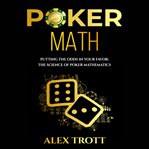Details
PUBLISHED
Made available through hoopla
EDITION
DESCRIPTION
1 online resource (1 audio file (3hr., 13 min.)) : digital
ISBN/ISSN
LANGUAGE
NOTES
Read by Bob Walker
In the game of poker, the two most fundamental mathematical ideas are known as probability and odds. Players who have a solid grasp of these ideas will be more equipped to make intelligent choices while competing. The possibility that an event will take place is referred to as its probability, and odds are defined as the proportion of the probability that an event will take place relative to the probability that it will not take place. When playing poker, players must determine their odds and calculate probability in order to determine whether or not they will win a hand. For instance, a player who already has a pair of aces has a 4.2% chance of hitting another ace on the flop, turn, or river of the hand they are playing. The odds of getting another ace are 22.5 to 1, which indicates that a player will get another ace once for every 23 times they have a pair of aces. In other words, the odds of getting another ace are 1 in 23. Players are able to make better decisions at the table by improving their ability to calculate odds and probabilities. If a player has a flush draw, for instance, they can determine their chances of getting a flush by counting the number of cards that are still in the deck that will complete their flush. This allows them to calculate their odds of hitting a flush. On the turn or the river, the player has a 19.1% probability of hitting their flush if there are nine cards left in the deck that will complete the flush. Another essential idea in poker mathematics is the concept of expected value, abbreviated EV. The expected value, or EV, of a bet is the amount of money that a player can anticipate winning or losing on average over the course of a long session
Mode of access: World Wide Web







